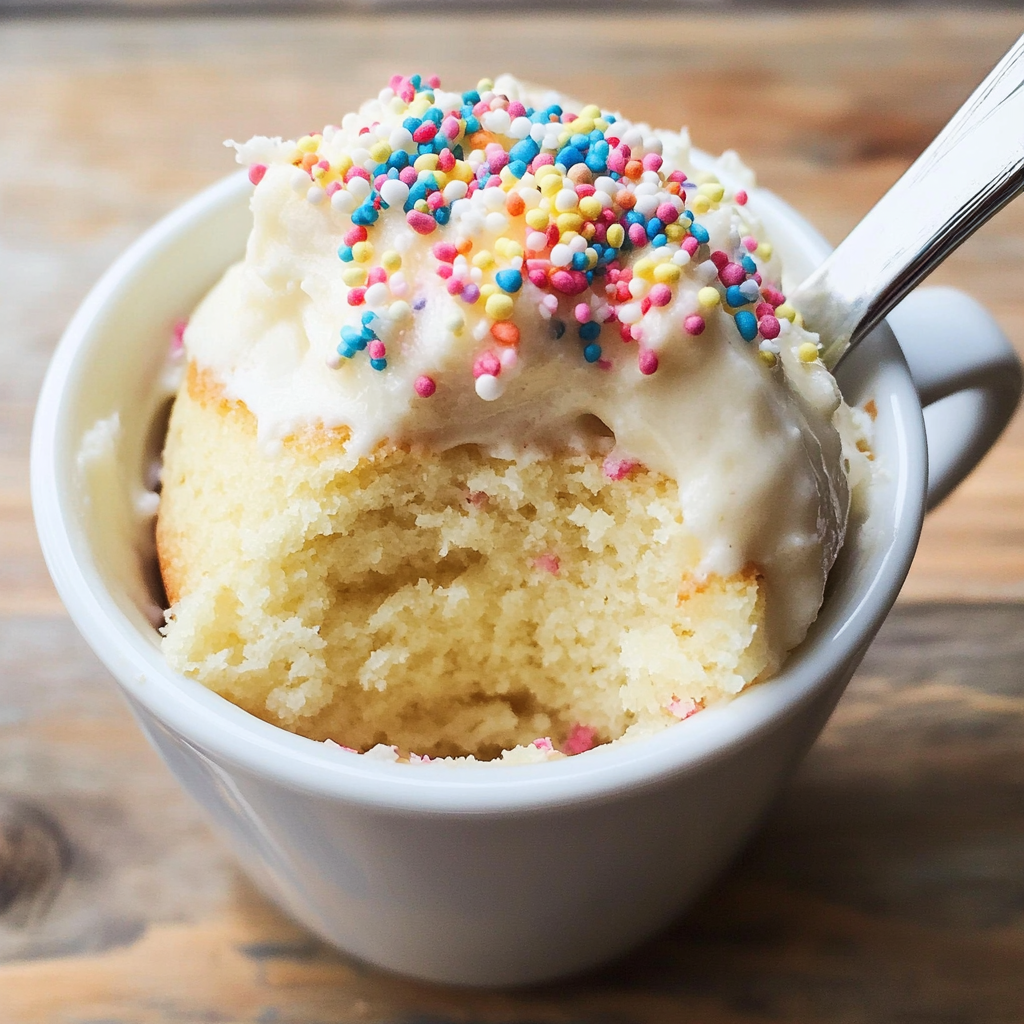Introduction to Vanilla Mug Cake:
Brief history and popularity:
Vanilla Mug Cake, a delightful and convenient dessert, has captivated the hearts of dessert lovers worldwide. This culinary innovation emerged from the desire for quick and easy sweet treats that require minimal ingredients and effort. The concept of a cake in a mug, cooked within minutes in a microwave, revolutionized the world of baking. It particularly gained popularity in the early 2000s, as online recipes and cooking shows began showcasing this novel idea.
The appeal of mug cakes:
The appeal of mug cakes lies in their simplicity and the instant gratification they offer. They cater perfectly to the fast-paced lifestyle of modern society, where time is precious, yet the desire for homemade comfort remains strong. Vanilla, with its universally loved flavor, makes the Vanilla Mug Cake a favorite among both amateur and seasoned bakers. Its versatility and the ease of adding personal twists have made it a beloved recipe for quick dessert fixes and impromptu sweet cravings.
Recipe Variations and Ingredients:
Classic Vanilla Mug Cake Recipe:
A Classic Vanilla Mug Cake offers a quick, delightful treat with just a few simple ingredients. Here’s how to whip up this delicious dessert:
Ingredients:
- 4 tablespoons all-purpose flour
- 2 tablespoons sugar
- 1/2 teaspoon baking powder
- 3 tablespoons milk
- 2 tablespoons unsalted butter, melted
- 1/2 teaspoon pure vanilla extract
Instructions:
- In a microwave-safe mug, combine flour, sugar, and baking powder.
- Add milk, melted butter, and vanilla extract to the dry ingredients. Stir until the batter becomes smooth.
- Microwave the mixture on high for about 90 seconds. The cake should rise and firm up.
- Let the cake cool for a minute before enjoying.
For more detailed instructions and expert tips, check out King Arthur Baking’s Vanilla Mug Cake Recipe.
Variations of Vanilla Mug Cake:
Gluten-Free Vanilla Mug Cake:
Replace all-purpose flour with a gluten-free flour blend. Ensure the baking powder is gluten-free too. This variation maintains the cake’s delightful texture while catering to gluten-sensitive diets.
Vegan Vanilla Mug Cake:
Substitute dairy milk with almond or soy milk and use plant-based butter or coconut oil. Swap sugar with a vegan alternative if desired. This vegan version ensures everyone can enjoy the quick treat without compromising on taste.
Keto and Paleo Options:
Use almond flour instead of all-purpose flour and a keto-friendly sweetener like stevia or erythritol. Replace regular milk with unsweetened almond milk. These substitutions make the cake suitable for those following keto or paleo diets.
Adding Flavors and Toppings:
- Chocolate Chips: Stir in a handful of chocolate chips for a gooey, chocolatey twist.
- Fruit: Add fresh berries or a spoonful of jam to the batter for a fruity flavor.
- Spices: Mix in cinnamon or nutmeg for a warm, spiced version.
- Nutella or Peanut Butter: Add a dollop on top or swirl into the batter before cooking for a decadent treat.
These variations and toppings add an exciting twist to the classic Vanilla Mug Cake, making it a versatile dessert for any occasion or dietary preference.
Discover creative ideas and variations at Tastes Better From Scratch.
Cooking Techniques and Tips:
Microwave Cooking Tips:
Achieving the perfect Vanilla Mug Cake in a microwave involves a few key practices. First, always use a microwave-safe mug to prevent any accidents or damage to your dishware. The size of the mug matters too; choose one large enough to allow the cake to rise without spilling over. Before cooking, evenly distribute the batter in the mug to ensure uniform cooking. Microwave wattage varies, so start with a shorter cooking time and increase as needed. Most mug cakes cook well within 90 seconds, but this can vary. After cooking, let the cake stand for a minute in the microwave. This resting period helps the cake finish cooking and settle. Lastly, clean your microwave regularly to avoid any odors or residue affecting the taste of your mug cake.
Troubleshooting Common Issues:
When making a Vanilla Mug Cake, you might encounter some common issues. If the cake turns out too dry, try adding a bit more milk or butter to the batter. This adjustment often creates a moister cake. If the cake isn’t rising as expected, check the freshness of your baking powder as it loses effectiveness over time. Uneven cooking is another common problem. To fix this, pause halfway through cooking and give the batter a gentle stir. This action helps distribute heat more evenly. If the cake is undercooked in the center but overcooked on the edges, reduce the microwave power level and increase the cooking time slightly. This slower cooking process allows the cake to cook more uniformly. Remember, every microwave is different, so it may take a few tries to find the perfect cooking time for your specific appliance.
Advanced tips and tricks:
Mastering the art of Vanilla Mug Cake baking involves some advanced tips and tricks that can elevate this simple dessert to new heights. Firstly, consider the mug you use: a wider mug distributes heat more evenly, reducing the risk of an undercooked center. If you’re aiming for a moist cake, try adding a tablespoon of yogurt or sour cream to the batter. This little addition can make a significant difference in texture.
Temperature control is crucial. If your microwave has adjustable power settings, experiment with baking the cake at 70-80% power for a slightly longer time. This gentler cooking process can prevent the edges from becoming too tough or rubbery.
For those who love a richer flavor, replacing some of the milk with brewed coffee can add a subtle but delightful depth. Also, don’t shy away from experimenting with extracts; a dash of almond or orange extract can beautifully complement the vanilla.
If you’re keen on a more layered dessert experience, try layering the bottom of the mug with fruit preserves or Nutella before adding the batter. As the cake cooks, this layer turns into a deliciously gooey filling.
Lastly, remember that mug cakes continue cooking for a short while after you remove them from the microwave. Letting the cake rest for a couple of minutes can prevent it from overcooking and helps to stabilize its structure for the perfect texture.
Nutritional and dietary information:
The caloric content and nutritional breakdown:
A typical Vanilla Mug Cake, while a delightful treat, often contains a significant amount of calories and sugar. On average, a single serving can range from 300 to 400 calories, primarily from carbohydrates and fats. The nutritional breakdown typically includes about 45 grams of carbohydrates, 4 grams of protein, and 15 grams of fat, of which 9 grams are saturated fats. The cake also contains approximately 38 mg of cholesterol and 300 mg of sodium.
Making healthier versions:
For a healthier version, you can make several adjustments. Reducing the sugar or using a natural sweetener like honey or maple syrup can lower the calorie count. Substituting all-purpose flour with whole wheat flour or almond flour not only adds nutritional value but also caters to those on gluten-free diets. Using skimmed or almond milk instead of full-fat milk can reduce fat content. Additionally, incorporating fruits like berries can add natural sweetness and beneficial nutrients, making the Vanilla Mug Cake a healthier indulgence.
Dietary information:
Vanilla Mug Cake, a popular quick-fix dessert, caters to various dietary preferences with its adaptable recipe. The classic version suits a vegetarian diet, avoiding any meat-based ingredients. However, it typically includes dairy and gluten, which might not align with vegan, lactose-intolerant, or gluten-sensitive diets.
For vegans, replacing dairy milk with plant-based alternatives like almond or soy milk and using vegan butter or coconut oil instead of regular butter makes the recipe vegan-friendly. Sweeteners can also be plant-based, like agave syrup or stevia, to maintain the vegan integrity of the dish.
Those who are lactose intolerant can easily substitute lactose-free milk and butter to enjoy this treat without discomfort. The recipe’s flexibility allows for these substitutions without compromising the cake’s texture or taste.
For individuals with gluten sensitivities or celiac disease, using gluten-free flour blends ensures they can enjoy this dessert safely. These blends often use rice flour, almond flour, or other gluten-free alternatives that provide a similar texture to regular flour.
Moreover, health-conscious individuals or those on calorie-restricted diets can modify the recipe to reduce sugar or use low-calorie sweeteners. They can also opt for low-fat milk and butter alternatives to decrease the overall calorie and fat content.
In summary, the Vanilla Mug Cake’s recipe versatility makes it a delightful dessert option for various dietary needs, from vegan to gluten-free, ensuring everyone can indulge in this quick and tasty treat.
Serving and Presentation:
Presentation tips:
Serving a Vanilla Mug Cake not only satisfies taste buds but also offers a chance to showcase your creativity in presentation. For an appealing look, garnish the top with a sprinkle of powdered sugar or a drizzle of chocolate syrup. Adding a scoop of vanilla ice cream or a dollop of whipped cream can transform this simple mug cake into a gourmet dessert. Fresh berries or a mint leaf provide a pop of color and a hint of freshness.

Pairing with beverages:
When it comes to pairing with beverages, the Vanilla Mug Cake’s versatile flavor complements a variety of drinks. For a classic combination, serve it with a cup of hot coffee or espresso. The bitterness of the coffee balances the sweetness of the cake, creating a harmonious blend of flavors. For tea lovers, a mug of Earl Grey or chamomile tea pairs wonderfully, offering a soothing and aromatic experience. On cooler evenings, enjoy your mug cake with a glass of warm milk or hot chocolate for a comforting and indulgent treat. These beverage pairings enhance the overall enjoyment of the Vanilla Mug Cake, making it a delightful dessert for any occasion.
This article provides a comprehensive guide to making and enjoying Vanilla Mug Cakes, ensuring a delightful and tasty experience for dessert lovers. For those interested in exploring other quick and delicious dessert options, check out our No-Bake Mini Cheesecake Recipe and Chocolate Cheesecake Recipe for more inspiration.
Print
Vanilla Mug Cake
- Total Time: 6.5 minutes
- Yield: 1 serving 1x
- Diet: Vegetarian
Description
A quick and delightful Vanilla Mug Cake that can be made in minutes, perfect for satisfying sweet cravings with minimal effort
Ingredients
- 4 tablespoons all-purpose flour
- 2 tablespoons sugar
- 1/2 teaspoon baking powder
- 3 tablespoons milk
- 2 tablespoons unsalted butter, melted
- 1/2 teaspoon pure vanilla extract
Instructions
- In a microwave-safe mug, combine flour, sugar, and baking powder.
- Add milk, melted butter, and vanilla extract to the dry ingredients. Stir until the batter becomes smooth.
- Microwave the mixture on high for about 90 seconds. The cake should rise and firm up.
- Let the cake cool for a minute before enjoying.
Notes
– Use a microwave-safe mug.
– Adjust microwave time based on wattage.
– Add toppings like whipped cream, chocolate chips, or fruit for extra flavor.
- Prep Time: 5 minutes
- Cook Time: 1.5 minutes
- Category: Dessert
- Method: Microwave
- Cuisine: American
Nutrition
- Calories: 300-400 kcal
- Sugar: 25g
- Sodium: 300mg
- Fat: 15g
- Saturated Fat: 9g
- Carbohydrates: 45g
- Protein: 4g
- Cholesterol: 38mg
Frequently Asked Questions about Vanilla Mug Cakes:
-
Can I make a Vanilla Mug Cake without eggs?
- Absolutely! Vanilla Mug Cakes don’t necessarily require eggs. The absence of eggs often makes the cake slightly denser but still delicious.
- How can I ensure my mug cake is fluffy?
- For a fluffy texture, ensure your baking powder is fresh. Also, avoid overmixing the batter, as this can lead to a dense cake.
-
Can I bake a Vanilla Mug Cake in an oven instead of a microwave?
- Yes, you can bake it in an oven. Preheat your oven to 350°F (175°C) and bake for about 15-20 minutes, or until a toothpick inserted comes out clean.
- Is it possible to make a Vanilla Mug Cake gluten-free?
- Definitely. Just substitute the all-purpose flour with a gluten-free flour blend.
- How can I add more flavor to my Vanilla Mug Cake?
- Experiment with add-ins like chocolate chips, a spoonful of peanut butter, or a sprinkle of cinnamon. You can also try different extracts like almond or coconut for a twist.
-
Can I prepare the batter in advance?
- It’s best to make the batter and cook it immediately to ensure the baking powder reacts properly and gives you a fluffy cake.
- How do I know when my mug cake is done?
- The cake should rise and the top should be firm to the touch. If unsure, do the toothpick test – it should come out clean.
-
Are mug cakes safe for kids to make?
- Yes, with adult supervision, especially when using the microwave. It’s a fun and easy recipe for kids to try.



